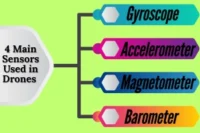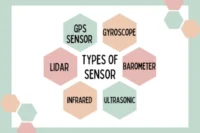Flying Right: Magnetometer Sensor in Drone Explained
Published: 31 Jul 2025
Have you ever wondered how your drone knows which way it’s pointing? The secret lies in the magnetometer sensor in drone technology. It works like a digital compass, telling the drone its direction at all times. This is especially helpful when flying manually or navigating tricky areas. Without it, your drone might turn the wrong way or lose its path. The magnetometer adds confidence and safety to every flight. So next time your drone flies straight and smooth, remember—it’s not just GPS at work, but the magnetometer too.
What Is a Magnetometer Sensor
A magnetometer sensor is a small device inside your drone that acts like a digital compass. Just like a regular compass uses Earth’s magnetic field to find direction, the magnetometer does the same for your drone. It helps your drone figure out which way it’s facing—north, south, east, or west. This is very important when the drone needs to turn or stay steady during flight. The magnetometer is part of the drone’s sensor system, working alongside GPS, gyroscopes, and accelerometers. With this tiny sensor, your drone can always stay on course, even in confusing environments.
How the Magnetometer Works in a Drone
The magnetometer in a drone works by detecting the Earth’s magnetic field, just like a compass. It senses which way is north and helps the drone understand its direction. This is how the drone controls its orientation, also called yaw or heading. When the drone turns left or right, the magnetometer helps it stay pointed in the right direction. This sensor becomes even more useful when GPS signals are weak or blocked—like when flying indoors, near large metal structures, or under thick trees. In those tricky spots, the magnetometer helps the drone stay balanced and avoid flying the wrong way.
Tips to Keep Your Magnetometer Working Well
To make sure your drone flies straight and stays safe, you need to take care of its magnetometer.
Calibrate Before Flight
Always run calibration using your drone’s app or controller before takeoff. This helps the magnetometer read directions correctly.
Avoid Magnetic Interference
Don’t launch your drone near cars, metal poles, or big speakers. These can confuse the magnetometer and cause wrong readings.
Start in Open Areas
Begin flying in wide, open spaces. This gives the sensor a better chance to get accurate direction data without blockages.
Keep Software Updated
Update your drone’s firmware regularly. This helps fix bugs and improves how the magnetometer and other sensors work together.
How to Handle Drone Errors
Sometimes, your drone might not behave as expected—and the magnetometer could be the reason.
Watch for Odd Movements
If your drone starts spinning, drifting, or flying in the wrong direction, the magnetometer may be giving bad direction data. This usually means it needs calibration.
Fix Calibration Errors
If the controller or app shows a Calibration Error don’t ignore it. Open the drone’s settings and run the calibration steps carefully before flying again.
Use Quick Fixes
Try these quick solutions: recalibrate the magnetometer, restart the drone, and move to a wide open area away from metal or electronics.
Calibrate After Travel
If you have traveled far from your last flying spot, always recalibrate. Changes in location or environment can affect how the magnetometer reads direction.
Where Magnetometers Matter Most
The magnetometer is not just a background sensor, it plays a key role in many flying situations.
Urban Flying
In cities with tall buildings, GPS signals can get blocked or bounce around. The magnetometer helps the drone stay steady and know which way it’s facing, even when GPS gets confused.
Manual Flights
FPV (First Person View) and racing drones often fly without full GPS help. These drones rely heavily on the magnetometer to control direction during quick turns and sharp movements.
Mapping & Surveying
For jobs like land surveys or building inspections, the drone must fly straight and follow planned paths. The magnetometer keeps the heading accurate, so the drone collects clean, usable data.
Agricultural Use
In farming, drones fly over crops to spray or scan fields. A good sense of direction helps them cover the area evenly. The magnetometer ensures the drone doesn’t miss a row or double back.
Conclusion
The magnetometer may be small, but it plays a big role in helping your drone fly safely and stay on course. It works alongside GPS to give your drone a clear sense of direction, especially when GPS signals are weak or blocked. By keeping your magnetometer well-calibrated and free from interference, you make every flight smoother and more reliable. Don’t overlook this tiny sensor—it’s your drone’s built-in compass. Remember: a well-calibrated magnetometer makes every flight smoother.
FAQs
The magnetometer helps your drone stay pointed in the right direction. It supports the GPS and keeps the drone steady, especially when GPS signals are weak. This makes flights safer and more stable.
If your drone spins, drifts, or flies in the wrong direction, the magnetometer might be off. You may also see a “calibration error” message. These are signs that the sensor needs attention.
Metal objects, cars, phones, and big speakers can confuse the magnetometer. These items give off magnetic signals that mess with the sensor’s readings. Always fly in open spaces away from metal.
Yes, but you still need to be careful. Indoors, GPS signals are weak, so the magnetometer plays a bigger role. Make sure there’s no metal nearby and calibrate before flying.





